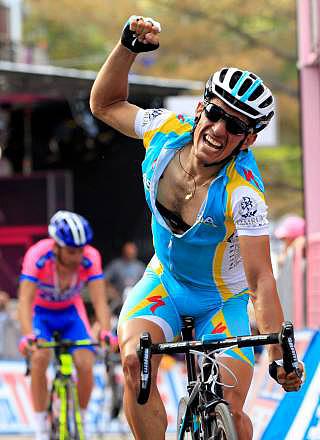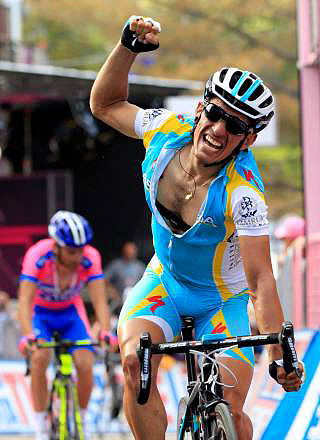After 201 kilometers of racing, everything was settled on the final step, one-kilometer climb at the end of Stage Seven of the Giro d'Italia.
With 500 meters to go Lampre’s Michele Scarponi launched a huge attack, dropping all the GC contenders except Astana’s Paolo Tiralongo who clung to the Italian’s wheel until the last 50 meters when the Astana rider pulled out and passed, winning the stage by four bike lengths.
“For a long time I was working for my team leaders and always gave everything for them,” Tiralongo told velonation.com. “Today I got a chance to ride my own race. I'd studied this finish and wanted to try and win. I stayed near the front, suffered and then went with Scarponi at 400m to go. I struggled to close the gap but as he looked around and eased up, I jumped past him and won. It hurt though, as everyone could see when I crossed the finish line.
“I don’t think I’m a champion or a great rider,” he continued. “I’m a good rider who works hard and helps his team leaders. I’m here to work for the team and won’t get big headed during the rest of the race.”
Tirolongo moved to second in the General Classification, behind Garmin-Barracuda’s Ryder Hesjedal, as pink-jersey-wearer Ramunas Navardauskas of Garmin-Barracuda couldn’t keep up over the climbs.
Astana’s directeur sportif Alexandr Shefer explained the team’s strategy on the Astasna website: “We managed to execute the plan we had prepared and Paolo was our man for the finish. He is doing very well at the moment and that’s why he was tasked with getting in a break at the finish or fighting it out in the sprint if the leaders approached the line in a bunch. He already got a number of good results in sprints at the end of mountain stages in the Tour de Romandie.
“During the last ascent we caught up with the various breakaways and managed to keep our cool right to the end, with the whole team performing brilliantly there.
“Tomorrow we will face a very tough stage with another summit finish. Paolo is only 15 seconds behind the pink jersey and we might have a little think about that, even though the team is riding for Roman Kreuziger and our end goal is the finish in Milan.”
Long, Lumpy Stage With a Fraught Finish
Stage Seven was long (202 km) and lumpy, but the climb everyone was focusing on was the last one, the 19-km 3.9-percent climb to Rocca di Cambio. While nto steep, the climb was veruy long at the end of a long stage; further, it finished with a short dip and then a final 1.3 km of much steeper climbing, with sections at ten percent.
Four riders got away near the start— Fumiyuki Beppu (Orica-Greenedge,) Matteo Rabottini (Farnese-Vini,) Reto Hollenstein (Netapp,) and Mirko Selvaggi (Vancasoleil)—but by the final climb this group was busy infighting as they realized their gap wasn’t big enough. Only Rabottini persisted, but he too faded on the final climb.
As expected, that final 19-km climb was the site of ongoing attacks after the initial four-rider breakaway dissolved.
Stef Clement of Rabobank was the first to try at the base of the climb; he lasted a kilometer before a large group of riders accelerated after him. Once he was caught, Colnago’s Stefan Pirrazi took off. He caught three of the fading breakaway riders and headed off after the sole survivor, Farnese’s Matteo Rabottini
Liquigas rider Valerio Agnoli, Lampre’s Danieli Pietropolli, and Movistar’s Jose Herrada set off with 15 km to go. Pirrazi caught Rabottini at the 13.7-km mark and tried to go right over the Farnese rider, but Rabottini clung to the Colnago rider’s wheel. 13 km out Katusha’s Angel Vicioso attacked.
Jose Herrada dropped Agnoli and Danieli Pietropolli and caught up to the leading pair with 12.3 km to go, while back in the peloton, Androni started a series of attacks: Emanuele Sella went first; Damiano Cunego led the catch. José Rujano made the next attempt, and when he was caught Carlos José Ochoa attacked. Apparently Androni’s directeur sportif ordered his team to go for the win, and why not?
Robottini cracked halfway up the climb—after riding in the lead for 192 km, the Farnese rider came up just a little short, but it was a good ride.
Androni’s Rujano took the head of the peloton and pushed the pace for a few hundred meters; then Astana’s Romain Kreuziger took over, cutting the gap to the leaders.
Up ahead, Pirrazi advanced in a series of spurts, opening short gaps over Herrada which the Movistar rider patiently erased. With 2 km left, the rode sloped down for several hundred meters. Pirrazi and Herrada charged, trying to preserve their 20-second lead.
1300 meters from the line Pirazzi nearly collided with a camera motorcycle, and then nearly hit the left-hand barriers. This gave Herrada a huge advantage, as Pirrazi lost all his momentum at the start of the final steep climb.
Herrada’s lead didn’t matter—the peloton swept him up 600 meters from the line, as Lampre’s Michele Scarponi moved to the head of the peloton, with Frank Schleck and Joaquim Rodriguez following. With 500 meters to go, everyone attacked—but it was Michele Scarponi and Paolo Tiralongo who were strongest. This pair dropped the rest and headed uphill alone.
Tiralongo rode Scarponi’s wheel until about 50 meters from the line when the Astana rider swung right and blasted past, opening a four-length lead by the finish line.
Scarponi probably didn’t care: he put a lot of time into his competitors, though he didn’t break into the top ten in General Classification. Scarponi moved to second in GC, but he is not likely to be there later in the race.
Ryder Hesjedal took over the race lead, with tow Garmin teammates, Christian Vande Velde and Peter Stetina, in the top ten. Katusha also has three in the top ten, with Joaquim Rodriguez third overall. Ivan Basso of Liquigas sits eighth, 40 seconds back.
Stage Eight is a long (229 km) trek from Sulmona to Lago Laceno, another lumpy stage with a Cat 4 early and a Cat 2 climb in the final ten km; the final few kilometers are downhill with a couple little bumps and the final 300 meters downhill. As with Stage Seven, there could be a swarm of attacks on the final climb.
| Giro d'Italia Stage Seven | |||
|
| rider | team | time |
| 1 | Paolo Tiralongo | Astana | 5:51:03 |
| 2 | Michele Scarponi | Lampre |
|
| 3 | Frank Schleck | RadioShack-Nissan | 0:00:03 |
| 4 | Joaquim Rodriguez | Katusha |
|
| 5 | Ryder Hesjedal | Garmin-Barracuda | 0:00:05 |
| 6 | Domenico Pozzovivo | Colnago | 0:00:09 |
| 7 | Daniel Moreno | Katusha |
|
| 8 | Ivan Basso | Liquigas-Cannondale |
|
| 9 | Mikel Nieve | Euskaltel-Euskadi | 0:11 |
| 10 | Gianluca Brambilla | Colnago |
|
| General Classification after Stage Seven | |||
|
| rider | team | time |
| 1 | Ryder Hesjedal | Garmin-Barracuda | 26:16:53 |
| 2 | Paolo Tiralongo | Astana | 0:00:15 |
| 3 | Joaquim Rodriguez | Katusha | 0:00:17 |
| 4 | Christian Vande Velde | Garmin-Barracuda | 0:00:21 |
| 5 | Peter Stetina | Garmin-Barracuda | 0:00:26 |
| 6 | Daniel Moreno | Katusha |
|
| 7 | Roman Kreuziger | Astana | 0:00:35 |
| 8 | Ivan Basso | Liquigas-Cannondale | 0:00:40 |
| 9 | Giampaolo Caruso | Katusha | 0:00:45 |
| 10 | Dario Cataldo | Omega Pharma-Quickstep | 0:00:46 |






